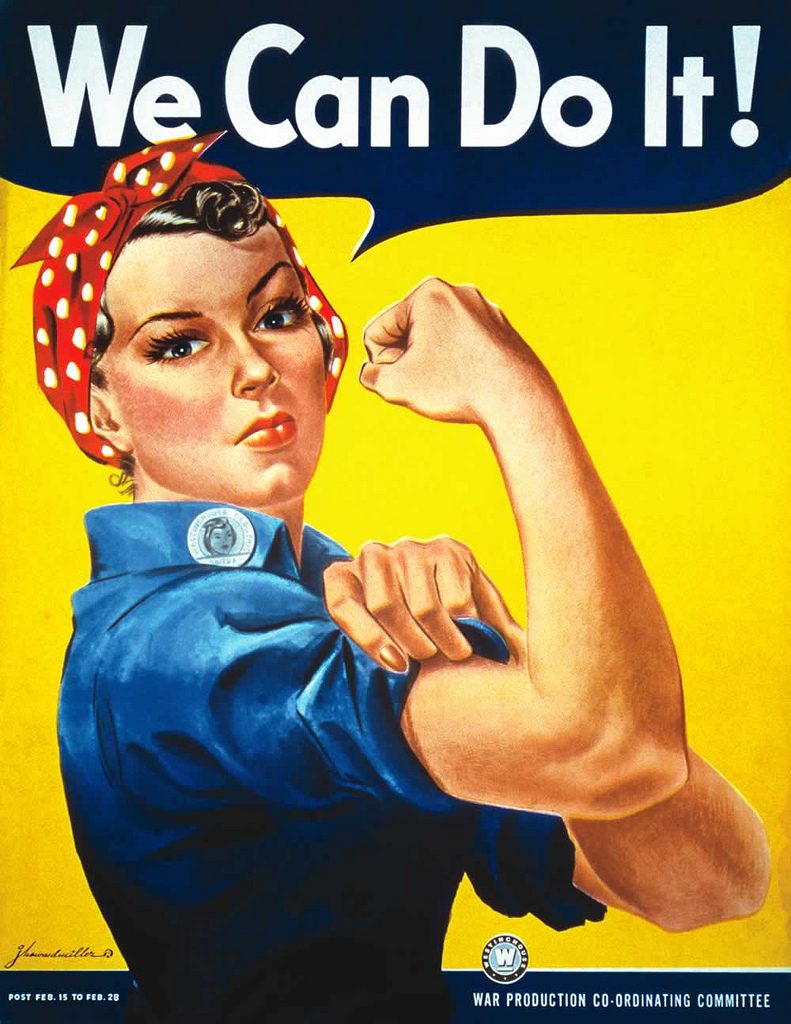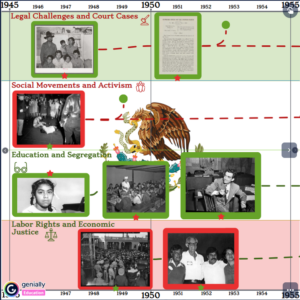From 1941 to 1945, during World War II, many woman were needed in the workplace because millions of men had joined the armed forces to fight in the European and the Pacific theaters of the war. In the Depression years just before this, women had been encouraged to stay at home, and let the men take the reduced number of manufacturing jobs available.1 With the onset of the war and the dramatically increased demand for manufactured wartime products, factories across the country opened their doors to women workers by the millions. In fact, there was a concerted effort to enlist women into the work force. In 1942, artist J. Howard Miller created the popular image of a woman named “Rosie the Riveter.” This poster was initially named, “We Can Do It!” and was made for the Westinghouse Electric and Manufacturing Company. Rosie was represented wearing makeup, a polka dot headband, and a rolled up sleeve shirt that portrayed strength and independence in women.2

Rosie the Riveter was a fictional character that many woman in the workforce identified with. The initial purpose of her image was to influence women to see themselves as capable of doing work previously thought to be men’s work. Her image combined beauty and strength, which is why many woman saw her as a role model. Even though Rosie the Riveter was a fictional character, her image was actually based on a photograph of a woman named Geraldine Doyle, who was a Michigan factory worker.3
There were some jobs that women took on that required training. Because of this, their wages were higher due to the fact that their jobs were more challenging and engaging compared to jobs that they may have had before. During the war, eighteen million women referred to themselves as being “Rosies.” Out of these eighteen million Rosies, six million had the opportunity to work for the first time. These women understood that the U.S. military and economy needed them; however, what motivated them to work was their own patriotism.4
In 1942, before Miller’s poster was created, Redd Evans and John Jacob Loeb wrote a song called, “Rosie the Riveter.” This hit song had lyrics that acknowledged and recognized the work that women did during the war:
All the day long whether rain or shine
She’s a part of the assembly line
She’s making history,
working for victory
Rosie the Riveter.
Keeps a sharp lookout for sabotage
Sitting up there on the fuselage
That little frail can do
more than a male will do
Rosie the Riveter.5
The song became associated with the existing images of Rosie the Riveter, which was a perfect blend of patriotism and beauty and strength in women.6
Unfortunately, after the war, the jobs and wages that Rosies had adapted to their lifestyles came to an end for the majority of them. Some went back to working “less challenging” jobs, and some became stay-at-home mothers. Because of this, birth rates increased, which led to the baby boom that lasted from 1946 through 1964. Even though many women went back to their previous lifestyles, they claimed to have left the workforce more confident and had more self-worth, knowing that they had proved to society that they were capable of doing men’s work.7
World War II changed the lifestyles of women significantly. Going from housewives to working in different industries allowed women to prove to society that this type of work was not just for men. There may have been no intention for women to prove themselves what they are capable of; however, women did leave their jobs after the war feeling better about themselves. Rosie the Riveter remains an iconic figure in American history, representing not only beauty in women, but also strength, courage, and confidence.
- Encyclopedia of Sex and Gender, 2007, s.v. “Rosie the Riveter,” by Susan L. Solomon. ↵
- America in the World, 1776 to the Present: A Supplement to the Dictionary of American History, 2016, s.v. “Rosie the Riveter,” by Nichola D. Gutgold. ↵
- Encyclopedia of Sex and Gender, 2007, s.v. “Rosie the Riveter,” by Susan L. Solomon. ↵
- Encyclopedia of Sex and Gender, 2007, s.v. “Rosie the Riveter,” by Susan L. Solomon. ↵
- Redd Evans and John Jacob Loeb, “Rosie the Riveter,” (New York: Paramount Music Corporation, 1942); The Four Vagabonds, “Rosie the Riveter,” recorded RCA Manufacturing Co., 1943. ↵
- America in the World, 1776 to the Present: A Supplement to the Dictionary of American History, 2016, s.v. “Rosie the Riveter,” by Nichola D. Gutgold. ↵
- Encyclopedia of Sex and Gender, 2007, s.v. “Rosie the Riveter,” by Susan L. Solomon. ↵



89 comments
Tyler Bradford
This was such a great article. I had no idea that Rosie the Riveter was originally based off a women named Geraldine Doyle. I love how this one figure or role model, though she is a fictional character, brought multitudes of women together to show that women are a force to be reckoned. Rosie helped to further prove that women can do so much more than what the opposite gender believes and I absolutely love that.
Ashley Tumlinson
I love Rosie the Riveter, in fact I dressed up as her one year for halloween! I love the significance she held in history and I love what she represented and stood for. Your article was very well – written. I enjoyed the song you included, because I had no idea she had a song about her! Additionally, it was interesting to find out that she wasn’t just a drawn up figure but also a representation of an actual female worker! that woman must feel pretty cool.
Liam Gillooly
Women played such an incredible role in the protection of our nation. The women who left their homes to work in factories were inspirational. To break a millennium old tradition required quite the bravery. The slogan and image of Rosie has inspired so many young women to seek new opportunities. Thank you for informing me of this topic.
Alexandria Martinez
Excellent article Marissa, it was very informative and I really liked how you included the song of Rosie in there too. I did not know that much about Rosie before, I certainly never knew that there was a whole song made about her as well. She is an excellent example of how woman can do the same things that men can do, and the women proved it during war time.
Brianda Gomez
I really enjoyed reading this article. This was one of the articles that caught my attention when I saw the picture of “Rosie the Riveter”. The great depression has always been interesting to me. This article really portrayed how life was for women during world war 2. The fact that these women were doing what was best for their country amazes me. It is so interesting how 18 million women came together to help their country. Rosie was a symbol for the hard-working independent women.
Valeria Hernandez
Marissa Gonzalez tells the story/ history of one of the most iconic images in American history. I enjoyed this article because it conveys the story of millions of women who were inspired by Rosie the Riveter during World War II. The author explains how women felt during the era, explaining that the image or advertisement helped females value themselves and help society understand that they are needed.
Mariah Cavanaugh
I love Rosie the riveter. In your article, you mention that many women saw her as a role model at the time and even today she remains an iconic figure in American History. I absolutely agree with you. When you think of the women’s movement and feminism, Rosie the riveter is an image that pops into my head. I thought I knew quite a bit about Rosie but apparently not, I had no idea there was a song written by the same name. This was a great article!
Rebekah Esquivel
I always knew that women had to work during world war II but I never knew what kind of jobs they had and what was asked of them. This has made me appreciate the job opportunities that I have today and although we may not be treated as equal as we want to men it is better then they were treated at that time period. I also didn’t know that Rosie the Riveter was based on an actual woman, seeing the picture of her in this article I can see the resemblance now. I used to have a poster of Rosie the Riveter on my wall she represented strength and power for women still until this day.
Alejandra Chavez
Reading this article made me a lot more appreciative of the life that I am able to live right now. I wasn’t aware of how many women joined the workforce in order to support the war but it’s amazing to see the staggering amount mentioned in the article. I found quite interesting that there was a song released about the fictional character. As a feminist, I found this article very inspiring because it stayed along the lines of “women not only had to do it but wanted to do it” and it described the way that the spark of women wanting to work with equal pay came to play today.
Cherice Leach
Of course everyone knows Rosie the Riveter! However, not everyone may not know the story behind her. I think you do a great job of explaining the fictional character Rosie the Riveter and her purpose in women’s rights. It’s amazing to see how so many women can be inspired by a fictional character. I believe Rosie gave the women of the US a real purpose and struck a confidence in them that would change the norms and traditions of US families, forever.